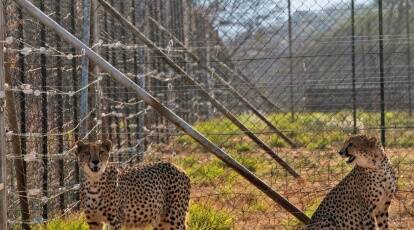New Delhi: India does not want fenced habitats for cheetahs like the ones in South Africa and Namibia as it is against the basic tenets of wildlife conservation, the head of the Centre’s high-level committee set up to monitor the cheetah reintroduction project said on Thursday.
Experts from South Africa and Namibia, who are helping reintroduce cheetahs in India, have recommended fencing their habitats to prevent poaching, habitat fragmentation and minimise human-animal conflict.
However, experts in India say fences can disrupt natural animal movements and impede genetic exchange between populations.
“It’s absolutely bogus to think of fencing the habitats. It goes against the basic tenets of wildlife conservation. What happened in a fenced park there (in Africa) will not happen here. Our understanding is that regional networks of protected areas should merge into a national network of protected areas so that there is porosity for wildlife gene flow,” said Rajesh Gopal, chairman of the 11-member cheetah steering committee.
“We have our own socio-cultural issues. We have been handling tigers for the last 50 years and we know what the human-wildlife interface is. We can handle cheetahs too,” he said.
South African wildlife expert Vincent van der Merwe, who is closely involved with the project, had earlier told PTI: “There has never been a successful reintroduction (of cheetahs) into an unfenced reserve in recorded history. It has been attempted 15 times in Africa and it failed every time.
“We are not advocating that India must fence all of its cheetah reserves, we are saying that just fence two or three and create source reserves to top up sink reserves.”
Source reserves are habitats that provide optimal conditions for reproduction of a particular species. These areas have abundant resources and favourable environmental conditions. They can support self-sustaining populations that produce a surplus of individuals, which can then disperse to other areas.
Sink reserves, on the other hand, are habitats that have limited resources or environmental conditions that are less favourable for the survival or reproduction of a species. Sink reserves rely on dispersing individuals from source reserves to maintain their population numbers.
Several experts, even the Supreme Court, have expressed concerns over the lack of space and logistical support in the Kuno National Park and have suggested shifting cheetahs to other sanctuaries.
Officials said the Gandhi Sagar Sanctuary, Madhya Pradesh, is being prepared as an alternative habitat for cheetahs by November.
Union Environment Minister Bhupender Yadav on Monday said officers and employees involved in the conservation and management of cheetahs will be selected and sent on a study tour to Namibia and South Africa as part of the project.
The central government will provide all necessary support, including financial resources, for the protection, conservation, promotion and a cheetah protection force, he said.
According to cheetah steering committee chairman Gopal, seven more cheetahs, including two females, will be released into the wild by the third week of June.
Prime Minister Narendra Modi released the first batch of eight spotted felines from Namibia into a quarantine enclosure at Kuno in Madhya Pradesh on September 17 last year.
In the second such translocation, 12 cheetahs were flown in from South Africa and released into Kuno on February 18.
Three cheetahs died in March and April. Of the 17 remaining adult cheetahs, seven have already been released into the wild.
A female Nambian cheetah gave birth to four cubs in March. Three of them have died due to heat exposure and dehydration.
Experts involved in the project say the mortalities are within the normal range.
To address the issue of cheetah-people interface, Gopal said a GIS-based landscape fragmentation analysis will be conducted to help the state authorities identify vulnerable areas.
“We cannot say the cheetahs will spend their entire lives in Kuno. They will enter human settlements and there will be some issues. We have to foresee and be ready for it,” he said.







